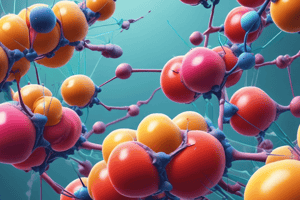Podcast
Questions and Answers
What are the four sets of reactions involved in glucose catabolism?
What are the four sets of reactions involved in glucose catabolism?
- Glycolysis
- Kreb's Cycle
- Electron Transport Chain
- All of the above (correct)
What occurs in Glycolysis Step 1?
What occurs in Glycolysis Step 1?
Glucose splits into 2 pyruvic acids.
Glycolysis Step 2 requires oxygen.
Glycolysis Step 2 requires oxygen.
False (B)
Glycolysis occurs in the mitochondria.
Glycolysis occurs in the mitochondria.
In Glycolysis Step 5, what is transported to the electron transport chain?
In Glycolysis Step 5, what is transported to the electron transport chain?
Match the glycolysis steps with their descriptions:
Match the glycolysis steps with their descriptions:
What is produced and diffuses out of the cell in Acetyl CoA Step 1?
What is produced and diffuses out of the cell in Acetyl CoA Step 1?
Acetic acid attaches to ____ for transport to form Acetyl CoA.
Acetic acid attaches to ____ for transport to form Acetyl CoA.
What is the reason the Kreb's cycle is called a cycle?
What is the reason the Kreb's cycle is called a cycle?
What happens to H+ and depleted energy electrons at the end of the electron transport chain?
What happens to H+ and depleted energy electrons at the end of the electron transport chain?
ATP is synthesized as electrons flow along the electron transport chain.
ATP is synthesized as electrons flow along the electron transport chain.
Flashcards are hidden until you start studying
Study Notes
Glucose Catabolism Overview
- Cellular respiration involves four main stages: Glycolysis, Acetyl CoA formation, Kreb's cycle, and Electron transport chain (ETC).
- Glycolysis is the first stage and occurs in the cytosol.
Glycolysis Steps
- Step 1: Glucose (6C) breaks down into 2 pyruvic acids (3C) through a series of 10 enzymatic reactions.
- Step 2: Glycolysis occurs without oxygen, qualifying as anaerobic respiration.
- Step 3: This process happens in the cytosol of all organisms, including bacteria.
- Step 4: ATP generated during glycolysis is used immediately by the cell.
- Step 5: NADH is produced and carries high-energy electrons to the electron transport chain in mitochondria.
- Step 6: Pyruvic acid conversion is contingent on oxygen availability:
- Anaerobic conversion results in lactic acid, which diffuses into the bloodstream and can be transformed back to pyruvic acid in the liver.
- Aerobic conversion allows pyruvic acid to move into mitochondria for further processing.
Acetyl CoA Formation
- Step 1: Pyruvic acid is transformed into acetic acid before entering the Kreb's cycle, producing CO2 and transferring H+ and electrons to NAD, forming NADH.
- Step 2: Acetic acid is then joined with CoA, creating Acetyl CoA for transport.
- Step 3: Acetyl CoA is introduced into the Kreb's cycle.
Kreb's Cycle Mechanics
- Step 1: CoA releases acetic acid to initiate the cycle and returns for more.
- The cycle regenerates the starting molecule, oxaloacetic acid, by completing a full turn.
- Each glucose molecule results in two cycles yielding:
- 4 CO2 expelled (2 per cycle)
- 6 NADH and 2 FADH formed, which move to the ETC for ATP production.
Electron Transport Chain (ETC) Process
- Step 1: Coenzymes (NAD and FADH) carry energy-rich electrons and H+ ions from glycolysis, Acetyl CoA formation, and the Kreb's cycle.
- Electrons detach from hydrogen, resulting in NADH and FADH, which enter the ETC.
- H+ ions remain, creating a concentration gradient in mitochondria.
- Step 2: ATP is synthesized during the electron flow along the chain, a process known as Chemiosmosis.
- Step 3: Oxygen acts as the final electron acceptor, crucial for the chain's function.
- Step 4: H+ ions, electrons, and oxygen combine to form water (H2O).
Studying That Suits You
Use AI to generate personalized quizzes and flashcards to suit your learning preferences.



